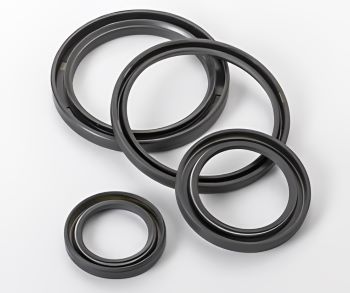Hydraulic cylinders are the workhorses of modern machinery. They go from the mighty arms of construction equipment to the delicate movements of factory robots. These parts turn hydraulic pressure into linear force.
Types of Hydraulic Cylinder Seals
Just like actors in a play, different hydraulic cylinder seals have specific roles:
➡️ Piston Seals: These are the stars of the show, forming a tight seal between the piston and the cylinder bore. They prevent pressurized hydraulic fluid from leaking past the piston, ensuring it pushes with full force.
➡️ Rod Seals: Imagine the piston rod as the main character’s trusty sidekick. Rod seals guard the area where the piston rod exits the cylinder head. They keep hydraulic fluid from leaking out while also preventing contaminants like dirt or dust from entering the system.
➡️ Wiper Seals: Think of wiper seals as the stagehands, constantly cleaning the piston rod. They wipe away any dirt or debris that might damage the rod seal or contaminate the hydraulic fluid.
These seals come in various materials like polyurethane or PTFE (Polytetrafluoroethylene). The material selection depends on the play’s setting:
➡️ High-pressure operations: Polyurethane with its exceptional strength might be the hero for heavy-duty tasks.
➡️ Extreme temperatures: PTFE, known for its heat resistance, might be the right choice for scorching environments.
Factors Affecting Seal Selection
Choosing the right hydraulic cylinder seal isn’t a one-size-fits-all situation. Here’s what influences the casting call:
➡️ Operating Conditions: Pressure, temperature, and the type of hydraulic fluid all play a role. High pressure demands a stronger seal. Extreme temperatures need a material resistant to heat degradation. The type of fluid used (mineral oil, water-based) should also be compatible with the seal material to prevent swelling or shrinking.
➡️ Friction and Wear: Seals need to strike a balance. They should create minimal friction to avoid energy loss but also be wear-resistant to last long under constant movement.
➡️ Compatibility: Just like actors who need to get along, the seal material and the hydraulic fluid need to be compatible. Incompatible materials can react with each other, causing the seal to degrade and lose its effectiveness.
Benefits of Using High-Quality Seals
Investing in high-quality hydraulic cylinder seals is like hiring a stellar cast and crew. Here’s the payoff:
➡️ Improved System Efficiency: Proper seals prevent leaks, ensuring all the hydraulic pressure translates into powerful force, minimizing energy waste.
➡️ Extended Equipment Life: Effective seals protect internal components from wear and tear caused by contaminants, extending the lifespan of your hydraulic system.
➡️ Reduced Maintenance Costs: Fewer leaks translate to less downtime and maintenance needs, saving you time and money in the long run.
Common Seal Failure Modes and Troubleshooting
Even the best actors sometimes miss their cues. Here’s how to spot hydraulic seal failure:
➡️ Leakage: The most common sign is a hydraulic fluid leak, indicating a worn-out or damaged seal.
➡️ Friction Issues: Excessive friction on the piston rod can signal seal damage or incorrect material selection.
If you suspect seal failure, here’s a starting point for troubleshooting:
➡️ Inspect the seals: Look for visible signs of wear, damage, or improper installation.
➡️ Check the hydraulic fluid: Contaminated fluid can contribute to seal degradation.
Maintaining Hydraulic Cylinder Seals
Prevention is always better than a dramatic breakdown. Here’s how to keep your hydraulic cylinder seals performing flawlessly:
➡️ Preventative Maintenance: Regular inspections and proper lubrication can significantly extend seal life.
➡️ Following Proper Installation Procedures: Seals are like delicate costumes; using the correct tools and techniques during replacement is crucial to avoid damaging them during installation.
Check out these resources for a richer knowledge on hydraulic adapters and fittings ⬇️⬇️⬇️
Harnessing The Potential Of Flared Pipe Fittings: Tips For Success
Maximize Efficiency With Swivel Adapters: Essential Techniques
How Does A Banjo Fitting Work: Exploring Its Inner Workings
Conclusion
Cylinder seals are the silent heroes. They keep these powerful parts running smoothly. Understanding the seal types, the factors affecting their selection, and the need for proper maintenance is key. It will keep your hydraulic systems at peak performance for years.
Remember, choosing the right seals and maintaining them well is an investment that pays off in the long run.
Post time: May-21-2024


